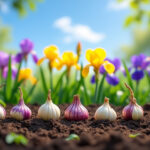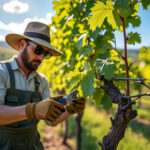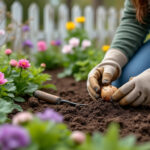A captivating addition to any garden, wisteria is known for its luscious clusters of vibrant flowers that can transform outdoor spaces into enchanting havens. Planting wisteria at the right time is crucial for ensuring it thrives and flourishes, providing beauty and fragrance. Understanding the optimal timing for planting, as well as the care and conditions needed for successful growth, can make all the difference in this magnificent climbing plant’s development.
- Choosing the right season for planting
- Ideal locations for optimal growth
- Maintenance and care tips for wisteria
Choosing The Right Season For Planting Wisteria
Wisteria is best planted during its dormant periods, specifically in the spring or autumn. In spring, as the frost subsides and the soil warms, wisteria roots can establish themselves before the vigorous growing season starts. Conversely, fall planting allows the roots to settle in cooler temperatures, well ahead of spring growth.
Spring Planting Considerations
When planting wisteria in spring, it is essential to wait until all danger of frost has passed. This ensures that the young plant can safely begin its growth cycle without the threat of cold damage. Additionally, this timing aligns well with the natural growth rhythm of the plant, allowing it to thrive as the weather becomes warmer.
Autumn Planting Considerations
In the fall, aim to plant wisteria about a month before the first frost, giving the roots ample time to take hold. This timing supports strong root growth, which is vital for the plant’s vitality in the upcoming spring. Keeping an eye on local weather patterns will help determine the best timeframe for planting.
Ideal Locations For Optimal Growth
Wisteria thrives best in full sun, preferably on south- or west-facing walls where it can soak up direct sunlight for much of the day. The vigorous climber is quite adaptable but flourishes in fertile, well-drained soil. It’s advisable to enrich poor soil with compost to facilitate robust growth.
Site Selection Tips
Choosing the right site is crucial. Wisteria is known for its rapid growth and ability to cling to nearby structures. It is recommended to plant it at least ten feet away from buildings to prevent potential damage to walls or roofs. A sturdy trellis or pergola can serve as a fantastic support, offering the vine an ideal framework to thrive.
When to plant nasturtium seeds for optimal blooming
Maintenance And Care Tips For Wisteria
Once established, wisteria requires consistent care to encourage blooming. Regular pruning is essential, typically done twice a year — in late summer after flowering and again in late winter. This helps promote fresh flowering growth on the new wood, ensuring a dazzling display each season.
Watering And Fertilization
Wisteria prefers moist but well-draining soil, making it important to water during dry spells, especially in sandy soils. Adding compost at the beginning of the growing season and using a dedicated fertilizer, such as Miracle-Gro or Burpee, can enhance growth and flowering potential. Monitoring moisture levels ensures the plants do not become stressed.
Potential Issues With Wisteria
If wisteria shows little to no blooming, it could be a sign of improper care. Factors such as excessive nitrogen can lead to robust foliage but few flowers. Ensuring an adequate amount of sunlight and performing regular pruning can help address this issue.
FAQs
What is the best time to plant wisteria?
The ideal times for planting wisteria are in the spring after the frost or in the fall a month before the first frost.
How often should wisteria be pruned?
Wisteria should be pruned twice a year, once in late summer after flowering and again in late winter.
Can wisteria grow in partial shade?
While wisteria can survive in partial shade, it will likely not produce flowers without sufficient sunlight.
What types of fertilizers are best for wisteria?
Using balanced fertilizers like those from Jackson & Perkins or Peaceful Valley can support wisteria growth and blooming.
Are there any toxic aspects to wisteria?
Yes, all parts of the wisteria plant are toxic and should be kept away from pets and children.
In summary, successful wisteria planting and care hinges upon choosing the right season, ensuring optimal sun exposure, and implementing a diligent maintenance schedule. With the right conditions, this stunning climber will reward any garden with an abundance of breathtaking blooms.
















